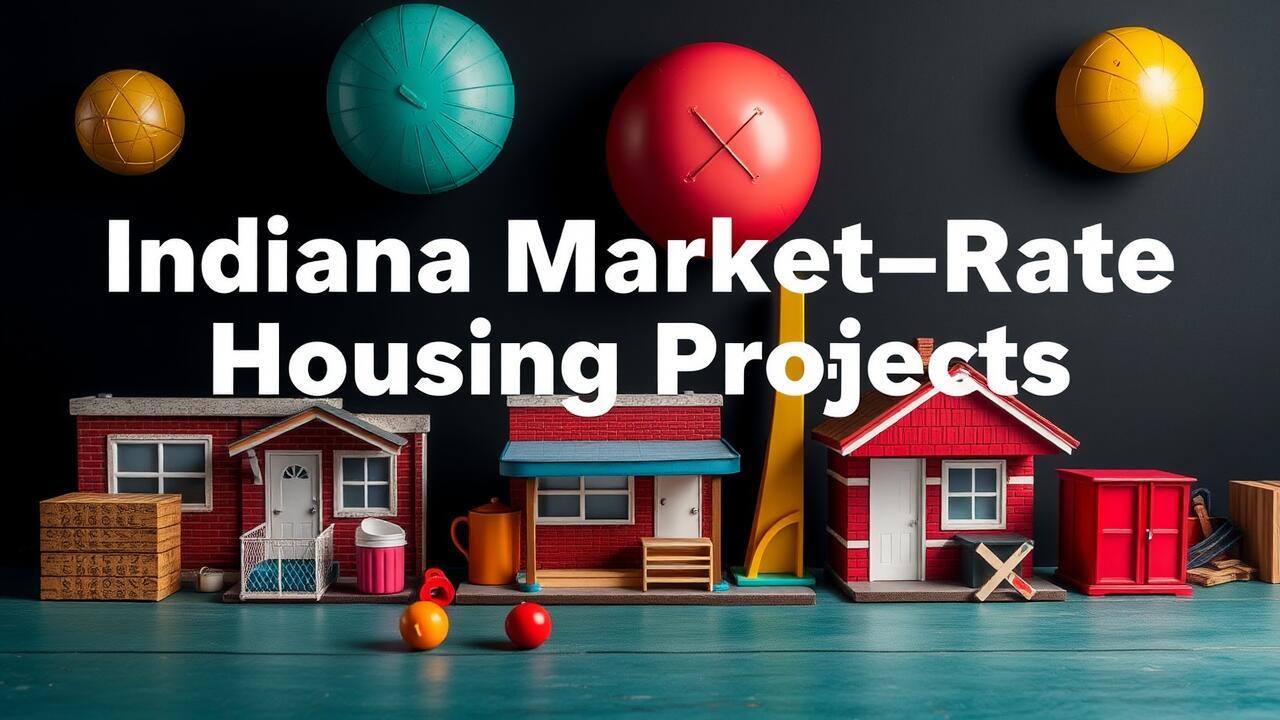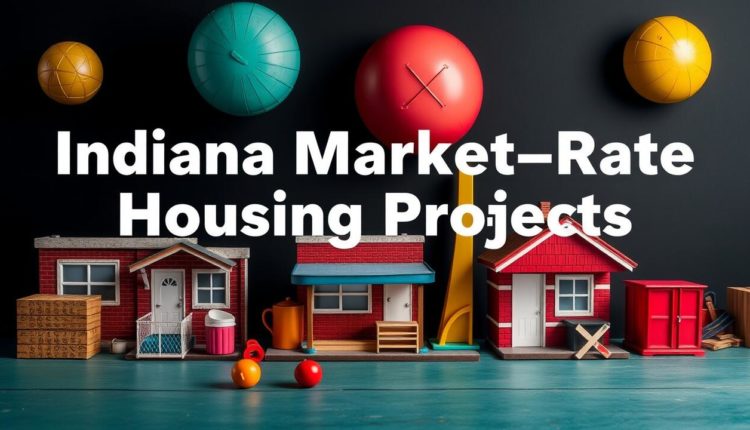Overview of Indiana Market-Rate Housing Projects
Indiana Market-Rate Housing Projects play a vital role in addressing the ongoing housing shortage within the state. These projects primarily include rental housing options, such as apartments and apartment buildings, which cater to a diverse demographic seeking affordable housing solutions. The dynamics of housing affordability are critical, particularly in urban centers like Indianapolis and its metropolitan area, where demand often outstrips supply. The Federal Housing Finance Agency has been instrumental in shaping housing finance policies that influence real estate development, thereby enabling more Indiana Market-Rate Housing Projects to take shape. This concerted effort aims to bridge the gap between high demand and limited availability, fostering sustainable growth within the housing sector.
Definition and Characteristics
Indiana Market-Rate Housing Projects are designed to cater to the needs of homebuyers seeking affordable yet quality living options in suburban areas. These developments typically include various housing types such as single-family homes and townhouses, appealing to a diverse range of homeowners. The projects aim to offer properties priced around the state’s median home price, making them accessible to families and individuals with varying household incomes. As the unemployment rate stabilizes and economic growth is projected, these housing projects play a vital role in enhancing real estate dynamics in Indiana.
The characteristics of these housing initiatives often reflect the overall economic development of the region. With locations near institutions like Indiana University Health, they attract both professionals and students, fostering a vibrant community. Growth rates in these areas highlight the demand for quality housing, driven by increased homeownership aspirations among residents. Indiana Market-Rate Housing Projects not only contribute to meeting housing demands but also augment local economies by generating jobs and stimulating community investments.
Importance in the Indiana Housing Market
Indiana Market-Rate Housing Projects play a vital role in shaping the overall dynamics of the housing landscape. These projects contribute to the diversification of housing options, enabling homeowners and renters to find suitable accommodations that meet their needs within various neighborhoods. With the increasing interest from real estate investors, the development of rental properties, such as condominiums, has surged, significantly impacting market trends. As property investment gains momentum, the availability of quality housing attracts new residents, thereby influencing the cost of living and price levels across the state.
The significance of these projects is especially pronounced in urban hubs like Indianapolis. The demand for market-rate housing has heightened as more individuals seek to navigate the complexities of renting versus buying. This has led to an upward pressure on rents, shaping the residential landscape. Real estate investors are keenly observing these shifts, recognizing opportunities in the commercial real estate sector that arise from the evolving preferences of tenants. The rise in market-rate developments is not only meeting the growing demand but is also instrumental in stabilizing the housing market for both homeowners and renters alike.
- Market-rate housing projects diversify the Indiana housing market by offering various accommodation options.
- Increased rental property developments help attract new residents to the state.
- Urban areas like Indianapolis experience heightened demand for market-rate housing, influencing rent prices.
- Real estate investors are capitalizing on opportunities emerging from changing tenant preferences.
- The surge in market-rate housing stabilizes the overall housing market, benefiting both renters and homeowners.
- These projects help balance supply and demand dynamics in the housing sector.
- Affordable and varied housing options contribute to community growth and development within Indiana.
Current Trends in the Indiana Housing Market
The Indiana housing market is currently marked by a noteworthy increase in demand for market-rate housing projects, driven by significant population growth in metropolitan areas like downtown Indianapolis. An influx of renters seeking condos and other rentals has spurred developers to respond with various new Indiana market-rate housing projects. The Indianapolis housing market reflects a growing preference among residents for modern living spaces while still grappling with the traditional aspiration of home ownership. Research from the Indiana University Kelley School of Business highlights how these trends are shaping the dynamics of both the rental and ownership sectors, influencing the overall landscape of the housing market. As the demand continues to rise, the balance between available options and affordability remains critical for prospective renters and buyers alike.
Demand and Supply Dynamics
The dynamics of demand and supply play a crucial role in the stability of Indiana Market-Rate Housing Projects. Recent housing market forecasts indicate a steady demand for market rate apartments, particularly with a notable market rate apartment community coming to Camby, Indiana. This influx is expected to attract a variety of Indiana households seeking more housing availability. As the local housing market adapts to these emerging projects, the focus on the affordable housing sector becomes increasingly relevant, especially given the challenges faced by the median Indiana household.
Housing demand remains strong across Indiana, influenced by factors such as population growth and job creation. The ongoing development of Indiana Market-Rate Housing Projects reflects a strategic response to the evolving needs of the community. As housing study data suggest, many housing markets in the region are witnessing a shift towards balanced offerings that cater to various income levels. This approach can help alleviate some pressure on the affordable housing sector while addressing the broader housing market dynamics across the U.S. housing market.
- Increased population growth in Indiana drives demand for housing.
- Job creation in the region attracts new residents seeking accommodation.
- Market-rate apartment developments cater to diverse income levels.
- Strategic housing initiatives aim to balance supply and demand.
- The expansion of housing options helps to ease pressure on affordable housing.
- Monitoring housing market trends is essential for community planning.
- Collaboration between developers and local governments can enhance housing availability.
Impact of Economic Factors
Economic factors play a significant role in shaping the Indiana Market-Rate Housing Projects landscape. Fluctuations in employment rates can directly affect the demand for high-quality housing options, impacting the ability of an Indiana homeowner to invest in new housing units. Various housing studies indicate that robust job growth often correlates with a healthy housing market, leading to major housing projects aimed at meeting the increased demand. As the Indiana housing market grows, the introduction of new housing units can help alleviate pressure on the affordable housing stock, particularly in urban areas.
Changes in housing supply are another crucial economic factor influencing Indiana Market-Rate Housing Projects. The balancing act between construction costs and property values affects the feasibility of affordable housing programs. In many cases, the affordability segment struggles to keep pace with the rising costs associated with new housing units. As seen in the Diego housing market, when economic conditions shift, they can prompt rapid housing supply changes that must be addressed to maintain an adequate stock of housing units. Ongoing monitoring of these economic conditions is essential for ensuring the long-term viability of Indiana’s housing landscape.
Analysis of the Indianapolis Housing Market
The Indianapolis housing market has shown significant growth patterns, reflecting the rising demand for Indiana Market-Rate Housing Projects. This momentum is driven by a diverse range of housing products catering to various housing segments, from luxury apartments to affordable housing tax initiatives that support workforce housing projects. High-quality housing developments increasingly appeal to both investors and potential homeowners, encouraging neighborhood homes investment. The dynamics of supply and demand continue to shape the landscape, as the Indiana business research indicates robust homeownership rates that further stimulate the new housing market. Understanding these trends is crucial for stakeholders looking to maximize ROI in Indiana’s evolving housing landscape.
| Housing Type | Average Price | Current Demand | Average Days on Market |
|---|---|---|---|
| Luxury Apartments | $250,000 | High | 30 Days |
| Single-Family Homes | $200,000 | Moderate | 45 Days |
| Affordable Housing | $150,000 | Very High | 20 Days |
| Townhouses | $180,000 | Moderate | 60 Days |
Growth Patterns in Indianapolis
Indianapolis has seen significant development in Indiana Market-Rate Housing Projects over the past few years. A robust housing trend of multi-housing townhouses has emerged, catering to a range of demographics including workforce housing pushes, entry-level homes, and senior housing developments. This trend is crucial given the tight housing inventory and rising average home values, indicating a need for more affordable homes. As a result, residential development companies are collaborating with the Indiana Finance Authority to create innovative solutions for various housing needs.
The growth patterns reflect a strategic approach to urban planning, with a focus on mixed-use developments that integrate ft. apartments alongside residential homes. Insights from sources like Inside Indiana Business highlight the momentum of these projects and their contribution to the local economy. The ongoing push for affordable options is essential in a market where demand continues to outpace supply, making the role of stakeholders crucial. For further information on housing outlooks, resources such as www.ibrc.indiana.edu/ibr/2022/outlook/housing.html provide comprehensive insights into the evolving market landscape.
Key Neighborhoods for Market-Rate Housing
Several neighborhoods in Indiana are gaining attention for their potential in market-rate housing development. Areas such as downtown Indianapolis and Broad Ripple are experiencing a surge in new apartment units designed to cater to diverse needs. With the demand for residential building rising, there is a pressing need for enough homes to accommodate hoosier households. As house price gains continue to reflect broader trends similar to the Seattle housing market, the local landscape for rental housing stays competitive. The introduction of new workforce housing is crucial to ensure that lower and middle-income residents can still find affordable options amidst increasingly expensive homes.
Another pivotal region is Fishers, where the influx of families has put pressure on rental units. The expansion of Indiana Market-Rate Housing Projects here has been influenced by federal housing finance initiatives that aim to stimulate development. Home prices in these burgeoning neighborhoods vary, impacting the availability of owner-occupied housing. As communities invest in market-rate housing, the principle that housing fosters community becomes evident, with new developments not only providing shelter but also enhancing local identity and connectivity.
Government Initiatives and Policies
Government support plays a crucial role in shaping Indiana Market-Rate Housing Projects, particularly in the context of current economic challenges. The Indiana Association emphasizes the need for effective policies to increase single-family housing starts and develop new apartments. This initiative is vital for maintaining a balanced real estate environment in the Indianapolis area, especially as rising mortgage rates impact home ownership affordability. With homeowner costs escalating and house prices rising, the rental vacancy rate continues to influence renter households within the rental market. Sustaining robust residential infrastructure will help accommodate the evolving dynamics of the real estate industry while addressing the challenges faced by Indiana Market-Rate Housing Projects.

Funding Opportunities for Housing Projects
Funding for Indiana Market-Rate Housing Projects often involves a combination of public and private investments. Economic Development Corporations play a key role in facilitating these projects, especially in metropolitan areas like the 11-county Indianapolis region. New apartment construction is being driven by the increasing demand for affordable units among potential homebuyers and renters. As average rent values continue to rise, the focus on creating market rate housing, including senior housing options, has become more critical to meet the needs of diverse populations.
The financial landscape for these housing projects is influenced by factors like current mortgage rates and house price appreciation. Potential homebuyers are particularly sensitive to buyer affordability, making access to funding initiatives vital for the development of projects that can offset rising monthly rent values. Partnerships with institutions such as Indiana University also enhance opportunities for funding, ensuring that market-rate housing can be developed in tandem with community growth and economic stability.
Regulations Affecting Housing Development
Regulatory frameworks significantly impact Indiana Market-Rate Housing Projects, influencing current construction rates and determining the viability of developments in high-demand neighborhoods. Local governments and redevelopment commissions often establish guidelines that dictate zoning, density, and land use. These regulations can affect home values and future price growth, making it essential for developers to comply with local laws while addressing needs for affordable options within the community. A five-year estimate of residential construction indicates an ongoing trend toward new market-rate projects, particularly in areas where average rents are on the rise.
The balance between encouraging economic development efforts and maintaining affordable housing is crucial for Indiana’s housing landscape. As cities grow and attract new residents, regulations must adapt to ensure that median-priced houses remain accessible amid escalating home values. Strategies to manage price growth are necessary to prevent high-demand areas from becoming exclusive. By navigating these regulatory challenges, Indiana Market-Rate Housing Projects can foster sustainable growth while balancing the needs of various income levels within the community.
Challenges Facing Indiana Market-Rate Housing Projects
Affordability issues pose significant challenges for Indiana Market-Rate Housing Projects, particularly in high-demand areas like Indianapolis. As rental developments continue to rise, current homeowners face pressure from rent increases that outpace wages. This dynamic impacts the local market, leading to higher rent prices and a tightening of available rental options. Forecasting mortgage rates and the implications of fixed mortgage rates further complicate the situation, as potential buyers weigh the option of homeownership against the escalating costs of median-priced homes. Economic development priority must address these challenges to ensure that rental demand can be met without pricing out a significant portion of the population, ultimately affecting the viability and attractiveness of Indiana Market-Rate Housing Projects.

Affordability Issues
Affordability concerns have emerged as a significant issue within Indiana Market-Rate Housing Projects, particularly for first-time homebuyers. Estimates indicate that rising rental prices in desirable neighborhoods are outpacing wage growth, making it increasingly difficult for new homeowners to enter the market. This situation is particularly pronounced in strong rental markets such as Knox County, Indiana, where urban living options have heightened demand but have not sufficiently addressed the need for affordable segments.
The imbalance between home sales and rental construction contributes to this challenge. As rental prices reach levels that many families cannot sustain, potential buyers face obstacles in securing homes at an affordable cost. The focus on new developments often prioritizes higher-end housing, which can neglect the needs of those seeking budget-friendly options. Addressing these affordability issues is crucial for the sustainability of Indiana Market-Rate Housing Projects and ensuring equitable access for residents across various income levels.
Conclusion
Indiana Market-Rate Housing Projects play a crucial role in shaping the state’s housing landscape. These projects often focus on developing one-bedroom apartments that appeal to young professionals and those relocating for job opportunities near employment centers. However, challenges related to affordability persist, making it essential for local governments to consider city incentives that can facilitate the development of more accessible housing options. The interplay between the availability of residential estate and the demand for affordable housing underscores the need for innovative solutions within Indiana’s housing market. By addressing these issues, stakeholders can enhance the viability and appeal of Indiana Market-Rate Housing Projects across the state.
FAQS
What are the current trends affecting the median home prices in the Indianapolis metropolitan area as related to Indiana market-rate housing projects?
The trends affecting median home prices in the Indianapolis metropolitan area include an increase in Indiana sales of U.S. housing units, which impacts the affordable housing segment. Residential development companies are focusing on new market rate projects to align with the growing demand. Moreover, organizations like Indiana Business Review analyze the ROI in Indiana, particularly in areas like Knox County Indiana, to assess development costs and the overall health of the housing market.
How can residential development companies impact the ROI in the Indiana housing market, specifically in the Indianapolis metropolitan area?
Residential development companies play a significant role in enhancing the ROI in the Indiana housing market. By investing in new projects, particularly in the Indianapolis metropolitan area, these companies help to improve the housing inventory and promote growth. Additionally, Indianapolis offers various incentives for development, making it an attractive location for residential development, ultimately benefiting the overall housing market in Indiana.
How can the growth of residential development companies influence the ROI in the Indianapolis housing market within the Indiana metropolitan area?
The growth of residential development companies can significantly enhance the ROI in the Indianapolis housing market, as these companies drive the expansion and improvement of housing options in the metropolitan area. Their investments lead to the construction of new homes, which can increase property values and attract more buyers, thereby positively affecting the overall market dynamics in Indiana. This, in turn, can boost the return on investment for existing homeowners and investors looking to capitalize on the expanding residential offerings in the region.
How do residential development companies improve the ROI in the Indianapolis housing market as part of the broader Indiana metropolitan area?
Residential development companies play a significant role in enhancing the ROI in the Indianapolis housing market by investing in new projects and revitalizing existing properties, which positively affects the overall value and attractiveness of homes in the Indiana metropolitan area. Their involvement can lead to increased demand, thereby influencing prices and overall ROI in Indiana’s housing market.
How do residential development companies contribute to the overall market dynamics in the Indianapolis housing market within the Indiana metropolitan area?
Residential development companies significantly impact the Indianapolis housing market by enhancing the availability of homes, which can lead to better ROI in Indiana. This growth can positively affect the metropolitan area home values, ultimately benefiting potential homeowners and investors alike.
How do the actions of a residential development company affect the ROI in the Indianapolis housing market in Indiana?
Residential development companies play a crucial role in the Indianapolis housing market by enhancing the ROI in Indiana through the creation of new housing options and improving existing properties. Their investments and developments lead to increased demand, which ultimately contributes to a more dynamic market, benefiting both residents and investors alike.
How do changes in the housing market dynamics of Indianapolis impact the ROI for residential development companies in Indiana?
Changes in the housing market dynamics of Indianapolis can significantly impact the ROI for residential development companies operating in Indiana. Factors such as supply and demand, property values, and local economic conditions directly influence the ROI in the residential sector. By adapting their strategies to these changes, residential development companies can enhance their performance and ensure sustainable growth in the Indianapolis housing market.
How does the effectiveness of a residential development company shape the Indianapolis housing market and its ROI in Indiana?
The effectiveness of a residential development company is crucial in shaping the Indianapolis housing market as it directly influences the ROI in Indiana. By focusing on quality projects and sustainable development practices, these companies can enhance property values and attract more buyers, which in turn boosts the overall performance of the housing market in Indianapolis and contributes to a positive ROI in Indiana.
How do the factors influencing the Indianapolis housing market affect ROI for investors in Indiana?
The factors influencing the Indianapolis housing market play a significant role in determining ROI for investors in Indiana. For instance, changes in housing demand, market supply, and economic conditions directly impact property values and rental income, thereby affecting the overall return on investment (ROI Indiana) for residential development projects in Jose housing market areas.
How does the development of new residential projects in the Indianapolis area contribute to the overall housing market in Indiana?
The development of new residential projects in Indianapolis plays a significant role in shaping the overall housing market in Indiana. These projects can enhance the availability of quality housing, attract new residents, and stimulate economic growth, leading to a more robust housing market throughout the state. As Indianapolis continues to expand, it fosters a competitive environment that can drive innovation and investment in the Indiana housing sector.


Comments are closed.